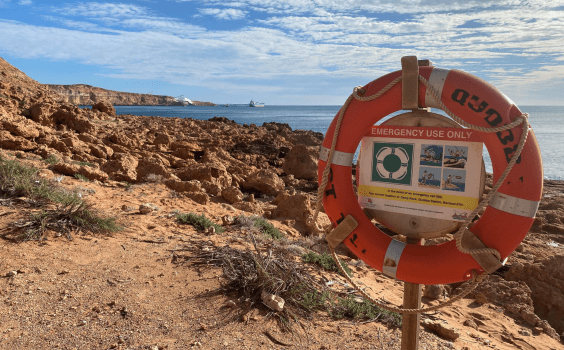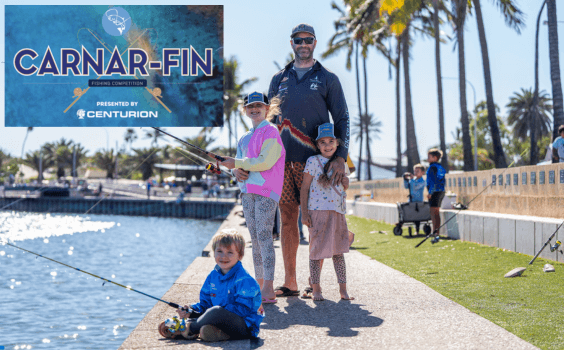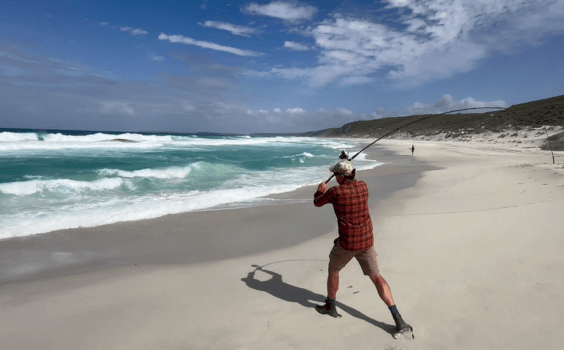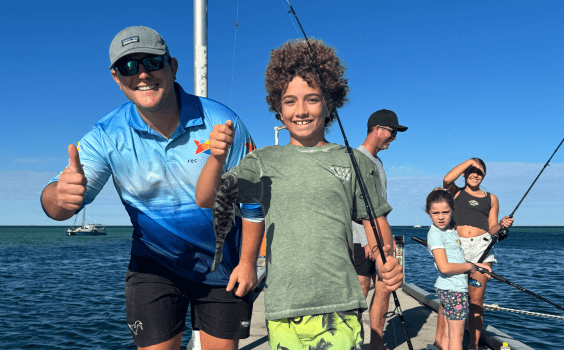“The taxman”, “the men in grey suits” or just plain old “bloody sharks.” Whatever you call them, sharks biting off your prized catch as you bring it into the boat can be the bane of many fishers’ fishing trips north of Geraldton.
As fishers prepare to head north for their eagerly anticipated winter fishing trips, we continue to arm you with information that can help reduce, if not completely prevent, the number of hooked fish lost to sharks.
A good starting point is this web page we have put together having talked to some of the experts with a bunch of good tips, one of which is avoiding areas where sharks are present.
But how can you tell if you’ve got sharks under the boat where you’re fishing? In this latest article we’ve talked to a number of fishers and charter fishing operators who regularly encounter sharks during their fishing trips and asked for their advice on how to spot sharks on your sounder. This can allow you to choose not to bother having a drop or a troll where they’re already present, or moving on as soon as you see them coming into your spot.

A sounder approach to limiting shark bite-off
With sounder technology going to the next level in the last decade or so – it means fishers can survey what is under the boat before dropping a line better than ever before.
While sharks have an advantage at picking up fish scents and fish struggling on the end of your line in a flash – to their distinct disadvantage they are relatively easy to spot on a sounder.
How do they stand out? Unlike scalefish generally targeted by fishers, sharks do not have gas-filled swim bladders.
This means they will generally appear as a continuous solid or even wavy line on sounders, rather than the curved arches that show up on the sounder screen that generally indicates scalefish.
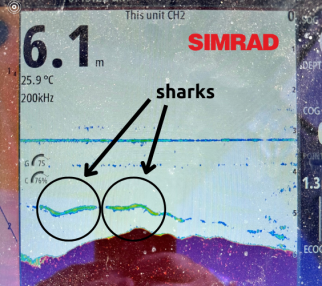

Josh Bruynzeel, skilled fisher and crewman from On Strike Charters in Exmouth, said sharks are easy to distinguish on all sounders, regardless of their price range or brand if you know what to look for.
“Sharks appear as a solid line that goes from left to right on your sounder rather than a fish arch,” Josh said. “They will also move under the boat and follow you regardless of your speed, whereas fish will generally sit on structure and tend not to move too much.
“You will get a solid echo from the front to back of sharks, the line doesn’t tend to fade either as it does with fish. Depending on the ping speed of your sounder, if it is higher you may also get multiple lines appearing on top of one another and that is a shark, but generally they appear as one long, continuous line and I would advise you don’t bother dropping a line if you see that on your sounder.”
Chris Tanti, a Simrad and Richter pro-teamer, and a recent winner of the Shimano WA Open in Jurien Bay, also said sharks are easy to differentiate from fish.
“The main difference between sharks and fish is sharks don’t have that arched ‘boomerang’ appearance on your head unit. Another factor is unlike bottom-dwelling fish that generally live close to the ocean’s substrate, sharks are generally higher in the water column and must ‘continually swim to live’ so to speak,” said Chris.
Chris Tanti also provided an array of other measures fishers can explore on their sounders during fishing trips.
“Because most fisherman aren’t targeting sharks, generally I wouldn’t play with your sounder settings too much. For instance, if you’re targeting bottom fish leave the settings that best suit you for that style of fishing. This is where bottom lock and depth line comes in handy to clearly differentiate the seabed from fish species,” said Chris.
“Another handy feature for pelagic fishers is TVG (or Time Variable Gain). Having this turned up will show you the ‘actual’ size of the fish as the head unit will work harder to show ‘true’ sizes of fish and sharks deeper in the water column. For example, if your TVG is set at 1, a 6-foot shark may look much bigger at 10 metres than say 20 metres.”
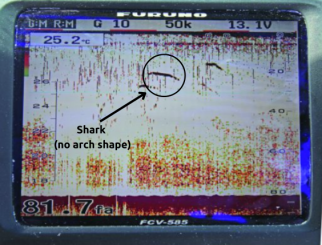
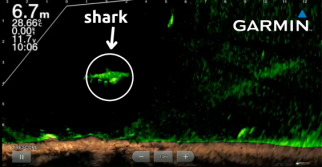
Be selective about the ground you fish
Josh also recommends steering clear of good-looking structure close to shore that is commonly fished, as sharks know hooked fish are easy targets at these locations.
While this kind of structure can look mouth-watering to anglers on sounders and often holds fish, sharks learn that these spots frequently see lines dropped down, leading to hooked fish and easy meals.
“The further away you travel from shore, the less likely it is you will come across sharks. I catch 99 per cent of my demersals off flat ground and most fishers don’t realise that bigger fish frequently sit under ledges only half a metre high.
“I don’t bother fishing big lumps or structure because it is almost always covered in sharks. I’ll fish mud, sand or rubble where fish will still gather but sharks don’t tend to,” added Josh.
Keep moving spots to keep the odds in your favour
Eddie Lawler, owner of Peak Sportfishing charters in Exmouth, said one of the easiest ways to avoid shark-bite off when fishing is to move spots frequently as boat activity and increased fishing action can act as a dinner bell for sharks.
“My biggest tip is to keep moving, regardless of whether you’re catching fish or not. As soon as we get one or two fish in the boat, we move spots immediately and try to put a fair amount of distance between each drop,” said Eddie.
“I’ll also do mock drifts over the spot I plan to fish with no lines in the water to analyse what it looks like on the bottom, to see if any sharks are in the area and to confirm the direction of the drift, but moving frequently is essential. Do not sit on a spot all day because your odds of getting sharked go through the roof.
“When we catch billfish, we also try to limit the amount of time that the fish are tied to the side of the boat and we never lift them out of the water. We release them as quickly as possible and don’t sit on one spot waiting to be sharked.”
If the fishing action is red hot at a particular spot, Chris Tanti said it’s wise to protect the future of that spot by not lingering for long.
“If you have a favourite ‘honey hole’ and suddenly lose a nice fish to a shark there – I’d highly recommend picking up and motoring (with haste) to another spot to protect that cohort of fish,” Chris said.
“I was bottom-fishing recently off Mandurah and hooked a solid dhufish before it got sharked and I only got the head back. There is absolutely no point in staying there when that happens, you’ll just lose more fish and knock off the local population without getting any fish on the deck,” said Chris.

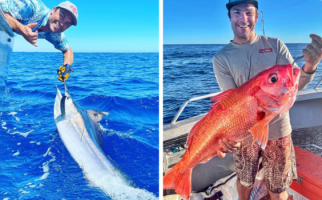
More shark tips from one of Australia’s best sportfishers
As for what to do once you hook a fish to keep it away from awaiting jaws, Chris has numerous tips you can try.
“For bottom fishing – especially deep dropping in places like Exmouth where sharks can be a real problem – I like to click the boat into gear once the fish is clear of the bottom as the sharks have learnt to follow the boat. This brings the catenary of the fish up on a larger angle.
“Once the fishes swim bladder expands and it starts to come up quickly, I usually try to get on top of the fish as quickly as possible. You can also throw diversions at the sharks such as bait if you have any.”
With a lot of impressive sportfish catches and experience under his belt, Chris also advised fishers should lower their drag right back when they hook a fish while trolling.
“For pelagic fish – don’t be afraid to almost free spool your reel if a shark is on its tail. Sometimes sharks give up on an easy feed if a fish powers away with speed and the fish is easy to chase down and get in the boat when you do that as its lactic acid has built up, meaning less work to land it safely. This is a great technique if you like using lighter gear and enjoy your sport fishing.
“Don’t be afraid to chase your fish down either in the boat if you’re trolling. If the fish is running away from the boat, chase it down and reduce the amount of line you need to reel in when it runs and this also puts the odds more in your favour,” added Chris.
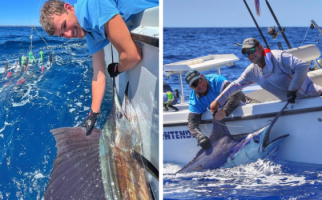
Chasing more tips on how to avoid sharks on your fishing trips? Check out our webpage containing all the best shark bite-off tips here.


